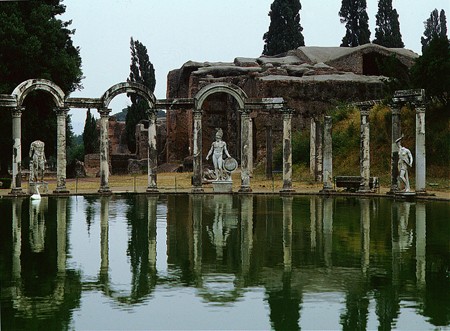The first chapter of my dissertation presents the textual evidence for this conceptual category. In those that follow, I demonstrate how this notion fundamentally shaped Roman visual culture, influencing the dynamics of civic space, domestic interiors, funerary commemoration, and items of personal adornment and illuminating key iconographic trends, especially those that have traditionally seemed problematic to the field.
In my discussion of civic environments, for example, I demonstrate how the concept of ornamentum governed the reception of Greek visual forms and directed their reappropriation in Rome. Taking replicas of works of Greek sculpture as a case in point, I argue that Roman reproductions of Greek statues were conceptualized not as copies of great Greek works but rather as powerful ornaments, which, in the fame and beauty of their much-replicated poses, held a cachet that brought honor to a recipient community.
Domestic ensembles, in their valorization of form, were also shaped by the prioritization of ornamentum. Roman visual culture shows a marked appreciation for nonfigural schema — a preference that has in the past appeared to conflict with ancient theories of aesthetic value based on naturalistic representation. But the concept of ornamentum embraced abstract works and naturalistic representations alike, thus making ample space for such forms to be valued. Furthermore, a perspective that celebrates maximum impact rather than harmony of form accounts for the visual cacophony that dominates abstracted Roman domestic assemblages on the Bay of Naples, where wall patterns contend with floor mosaics in separate attempts at ornamentation.
In my study of the funerary context, I trace the impact of the value of ornamentum across the peoples who inhabited the Roman Empire. I argue that ornamentum located Roman identity in a concept that was visually flexible and so allowed for a proliferation of successfully honorific localized monumental forms. Thus, in a group of late antique Romano-Hispanic tomb mosaics of a style long criticized for awkward representation, naturalism was not the issue. Achieving ornamentum carried primary importance, and these grave portraits sought not so much to represent the deceased accurately as to lend beauty and honor to their resting places. The accompanying inscription, sepulchrum adornavit, makes the intention clear.
Finally, focusing on objects of jewelry, I demonstrate how the breadth of the category of ornamentum led to a cross-fertilization of media that has traditionally been overlooked. Possibilities of reference among jewelry, painting, and sculpture were richly developed in Rome, for example, with jewels inserted into the painted walls of the Horti Lamiani palace. We also see quotations of form and motif across these media, from fourth-century domestic frescoes such as those on Rome’s Clivo di Scauro, which employ jewelry’s tessellations of colored shapes, to hairpins modeled in the pose of the famous Venus Pudica statues. Arts currently treated separately were then clearly in dialogue with one another.
The core value of ornamentum thus provides insight and suggests solutions for key problems across the material repertoire of Roman visual forms. Informing conditions of viewing and values of making and design, it is a governing concept for Roman visual culture.
